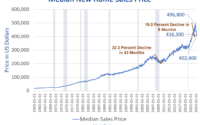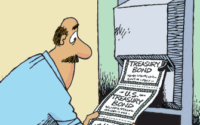Just a day after Federal Reserve policy makers delivered their biggest rate hike in 28 years, the U.S. inflation outlook continues to look dire in one obscure part of the financial market.
Traders of so-called fixings, or derivatives-like instruments related to Treasury inflation-protected securities, expect four straight months of annual headline consumer-price index readings at roughly 9% or higher from June through September. That would be the longest stretch of such elevated readings since 1981 — the same year that the Fed, led by Paul Volcker, was forced to push the fed-funds rate target to as high as 20%, according to FactSet data. The outlook for a roughly 9% September CPI rate has been in place since May’s CPI report was released last Friday, one trader said.
Fixings traders have proven, over the past year, to have a better handle on where inflation is most likely to go than most professional forecasters and even the Fed itself. That’s because they’re able to adjust their expectations on a frequent and daily basis — unlike economists who reveal their forecasts on a less-rapid schedule. On Wednesday, policy makers released projections showing that they think inflation, based on their preferred measure, will move toward more normal levels, below 3%, starting next year.
“Fixings traders are saying inflation is not only not coming down, it is probably accelerating,” said Gang Hu, a 20-year veteran of TIPS trading with New York hedge fund WinShore Capital Partners.
Driving much of the anticipated rise in inflation is Russia’s war in Ukraine, which is seen pushing food and energy costs higher, he said. But even core inflation, which excludes food and energy, is seen as likely to come in at 0.5% or 0.6% on a month-over-month basis over each of the next three months, in line with the April and May core readings.
Wednesday’s 75-basis-point rate hike and policy update by the FOMC, or rate-setting Federal Open Market Committee, “made no difference” to fixings traders, said Hu, who also trades CPI fixings. “Whatever the Fed does is very unlikely to change CPI in the next few months because Fed action will have a lag of 6 to 12 months. Whatever the Fed does is not massively going to change the market’s thinking in two to three months.”
The signals being flashed by the fixings market are worrisome for a number of reasons. One is that trades in the fixings market aren’t easily accessible, which will likely leave many investors and traders caught off guard with where inflation could actually be headed. Another is that, even though policy makers favor core readings as a more accurate gauge, it is the headline CPI number which impacts expectations.
In his postmeeting press conference on Wednesday, Federal Reserve Chairman Jerome Powell made a point of calling out the latter point, by saying headline readings “are what people experience” and “expectations are very much at risk due to high headline inflation.”
See: Here’s the comment from Powell that could make it hard for the Fed to slow down the pace of interest-rate hikes
The fixing market’s implied levels for CPI through September, if anything, “are marginally cheaper since the Fed’s meeting, but they’ve been up there for quite some time,” said Chris McReynolds, head of U.S. inflation trading for Barclays PLC.
Transcript: Fed Chief Powell’s Postmeeting Press Conference
“Monetary policy certainly acts with a lag and the market is saying monetary policy is not going to ease the oil shortage in the next two months, and it’s not going to help food prices or get wheat out of the Ukraine in the next few months,” McReynolds said via phone on Thursday. “For the next few months, the fixings market realizes that the main sticking points of inflation are something raising rates are not really going to take care of.”
A post-FOMC relief rally in stocks on Wednesday is giving way to a broad-based selloff. As of Thursday afternoon, U.S. stocks were broadly lower, with Dow industrials
DJIA,
down by almost 700 points. The S&P 500
SPX,
and Nasdaq Composite
COMP,
were lower by 3.1% and 3.9%, respectively. Meanwhile, investors flocked to government bonds, pushing down the yields on 2-
TMUBMUSD02Y,
through 30-year Treasurys
TMUBMUSD30Y,
And oil futures traded mixed.
As of Thursday, data compiled by Bloomberg indicated that fixings traders expect the annual headline CPI rate to come in at 8.97% and 8.95%, respectively, for June and July — up from May’s 8.6% level. From there, year-over-year CPI is expected to hit 9.15% in August and 9.08% in September before gradually falling off to 4.7% in May of next year.
“I can’t dispute what they’re saying,” said John Farawell, executive vice president and head of municipal-bond trading at Roosevelt & Cross in New York. “Everything is spelling recession right now. It seems like stagflation is already here.
“Our financial market is very resilient because the amount of cash floating around is enormous and we still have outside money coming into the U.S., but we will have to see how this plays out,” Farawell said via phone. “The war in Ukraine does not seem like it’s going away and it’s going to continue to put pressure on inflation.”


